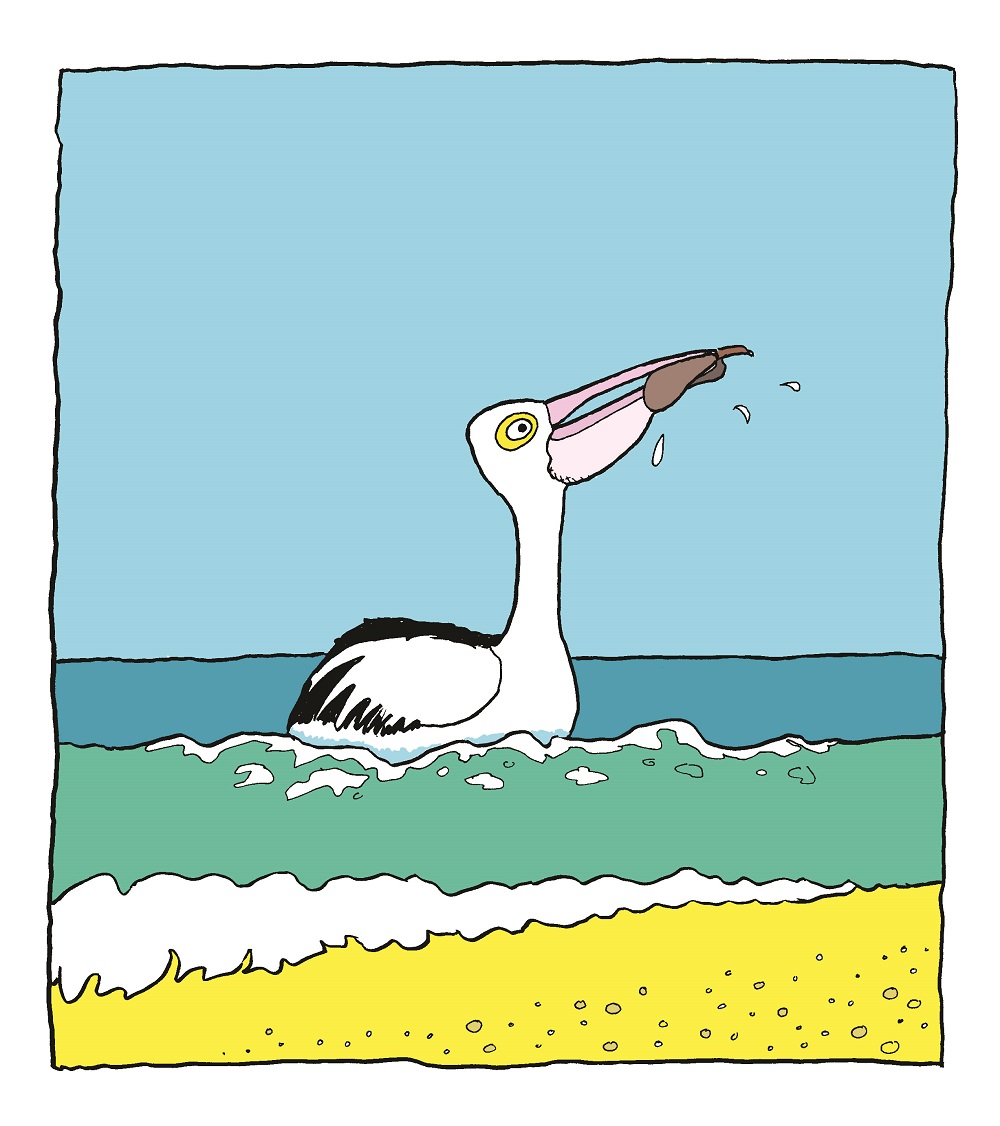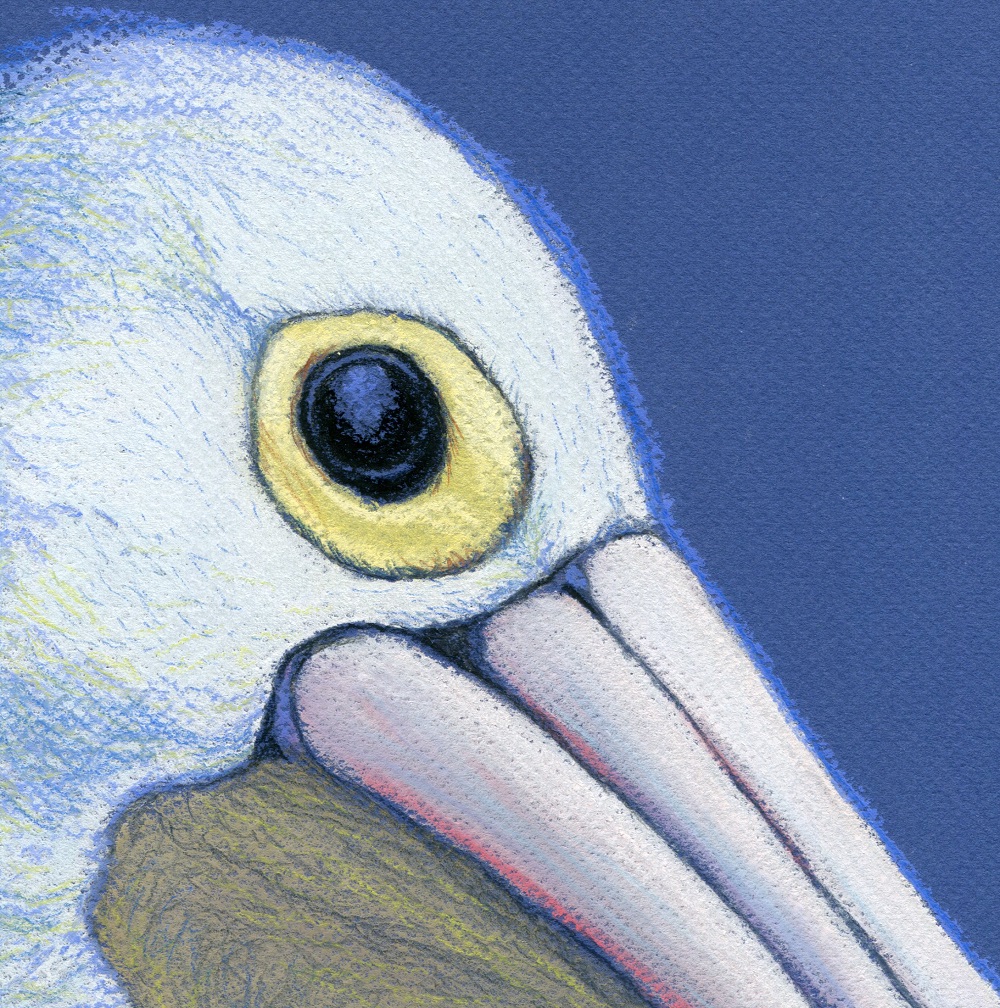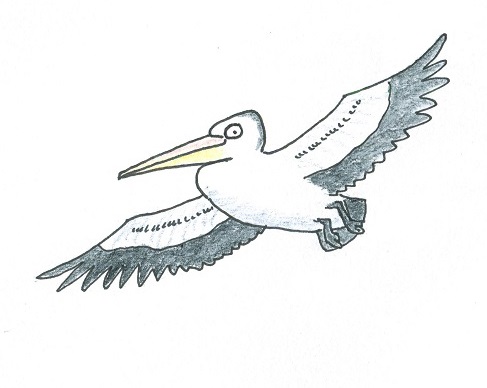
A lone pelican fishing at Bribie Island.
I was sitting on a nearly-deserted Bribie Island beach last week, with only sand, sea, and bushland all around. An osprey was hunting nearby, and a few terns drifted past. The tide was up, and we’d just been for a dip – but only as far as a shallow sand spit, only metres from the shore.
Then around the point a pelican came flying – slow and solemn. Purposeful. It landed on the sea, near the shore, about 100 metres away, and proceeded to swim steadily towards us.
Most people probably encounter pelicans hanging around jetties, scavenging discarded fish, or perched atop light poles. But once you’ve recognised their slow, gliding flight you won’t forget it – often very high overhead, circling on a thermal. Pelicans have more secondary flight feathers than many other birds (which creates a large wing surface area)¹, extra muscles to keep their wings outstretched, and a body that is surprisingly light². This allows them to glide upwards on thermals to attain great heights and to move between thermals to cover long distances, but all for relatively little effort.
Pelicans have an air of calm acceptance and composure. Or maybe discreet scheming. The Australian pelican eats mostly fish, but it’s also been known to swallow ducks, small dogs, and to eat silver gulls after holding them underwater til they drown. Australian pelicans are also renowned for hunting in groups – driving smaller fish together until they can be easily scooped up in those enormous bills (the largest bill of any bird¹). So why was this lone pelican swimming towards us? Did it think we had fish? Perhaps it was attracted to our two smallish dogs?
The pelican swam until it was directly in front of where we were sitting – roughly above the shallow sand spit – and proceeded to fish. It looked intently down into the water, and then quickly plunged its head in – emerging with a dinner-plate-sized round and flattened fish in its bill. It then tipped up its bill – the fish was engulfed in the pink fleshy pouch below – and after a minute or two the pelican somehow managed to swallow it. The bird soon caught and swallowed a second round, flat fish, and a then a third. Even though the pouch of a pelican can be hugely distended (and can hold up to 14 litres of water³) its body really isn’t all that big. We were wondering how many more fish it could fit in.
I felt strangely relieved that we weren’t expected to provide food, and a bit ashamed that I had underestimated this bird. It obviously knew exactly where to get a good feed – it hadn’t attempted fishing until it reached the sand spit and then had immediate success – and it may have been coming to this exact spot for years. Today we were probably just inconsequential onlookers in its usual routine.
The beach walk was my birthday treat, so I wondered how old was this pelican? I later read that one Australian pelican – in captivity – lived for 60 years. Another was banded in the Coorong of South Australia in 1985 and was found 26 years later (only 2 km away from its initial banding site), safe and well, and still going strong♠. So this Bribie Island bird could be as old as me, and perhaps it had learnt over the years many details about where and when to fish, roost, breed (and find small dogs).

The Australian pelican (Pelecanus conspicillatus) is also known as the Spectacled pelican, because of the ring of yellow skin around each eye.
The Australian pelican is usually found in coastal areas, or on more permanent inland water bodies. But it is also famous for migrating into the arid heart of Australia when occasional big rains flood the otherwise dry salt lakes. At these times, huge numbers of fish appear, seemingly out of nowhere, and vast numbers of pelicans assemble and form breeding aggregations. These high rainfall events happen irregularly, and are difficult to predict. How do the pelicans know when a usually dry salt lake – hundreds of kilometres away – is filling with floodwaters and fish?
Some people think that the older, more experienced pelicans learn the signs (or perhaps the scents, as scientists are now discovering that birds have a far better sense of smell than once thought). And that these wise birds lead the younger pelicans to the inland breeding grounds. A single pelican has been observed taking off and spiraling slowly up a thermal, and then many other birds take off to follow it. If the lead bird then glides off in a particular direction, the other birds peel off the thermal, one by one, and follow it♦.
The pelican on Bribie Island bobbed along in the calm water before us, drenched in that bright golden Queensland sunlight, and goggled at me with its yellow-rimmed eyes (maybe slightly bulging from all the fish it was still trying to swallow). A wise bird, no doubt. Perhaps a leader. I wondered how many trips it had made to inland Australia? The largest distance that a pelican has been known to fly is 3219 km from the Coorong of South Australia to the Gulf of Papua, Papua New Guinea♠. But maybe that’s nothing if you’ve got a few good thermals, and can follow a pelican who knows where it’s going.

1. The Unfeathered Bird by Katrina van Grouw.
2. The Handbook of Australian, New Zealand and Antarctic birds. Vol. 1. Ratites to ducks. coordinated by S. Marchant and P.J. Higgins
3. Stray Feathers : Reflections on the Structure, Behaviour and Evolution of Birds by P. Olsen and L. Joseph
♠ Database of the Australian Bird and Bat banding scheme
♦ Boom and Bust : Bird Stories for a Dry Country by L. Robin, R. Heinsohn and L. Joseph

My dad used to tell the story that whilst cleaning some fish on the side of Wallis lake at Forster, NSW he once watched a ladies horror as a pelican scooped down from the sky and collected her Chihuahua she was walking, only to stand there helplessly as she watched the pelican fly off into the distance with the lead hanging out its beak….
Ha ha ha! Oh dear, even though I love dogs I do find that wickedly funny…. Do you think he really saw this (no disrespect to your dad), or was he pulling your leg? The mention of pelicans eating small dogs in HANZAB sounded slightly incredulous, but then they do eat their siblings, and cannibalise other pelicans… So it’s definately plausible. Thanks Annie for reading and commenting.
Hi Paula,
I’m very fond of pelicans so I really enjoyed reading more about them in your blog post. Lovely illustrations as well. I read Colin Theile’s “Storm Boy” as a child and it left a strong impression on me. I’ve spent many hours just watching pelicans and gulls on the beach. Thanks for another great post. Best wishes. J
Hey Jane thanks for your feedback, they really are terrific birds, and seem to have a lot of things quietly worked out… I hope those parrotty glands stop squawking and calm down soon. Cheers, Paula
According to Dr John Read research fellow Adelaide Uni pelicans move to inland breeding sites only when fish are in high numbers, this can be two years after the initial rainfall event, no-one has satifactorily explained how they do this. Also, when I see a pelican I also see a dinosaur, so keep your small dogs on a tight leash.
Hi Peter, I think a sense of smell has something to do with it, but it’s a hypothesis that would be difficult to test. Researchers in Finland have demonstrated that plants emit particular chemical compounds when they are attacked by insects, and that insectivorous birds are attracted to these compounds, and turn up and eat the insects. Perhaps the scent of fish might be blown large distances on the hot winds that periodically blow from inland Australia to the coast? And yes, I’m keeping my dogs well away from the next pelican I see, but they’re so fluffy I doubt even a pelican could swallow them easily. Thanks for reading and commenting! Paula
Great stories … yours and the comments … love the vision of a Pelican with a leash hanging out. And of course we should not let the facts get in the way of a good story.
We are regular Bribie visitors and always comment on the Pelicans roosting on the bridge lights.
Michael
Thanks Michael for reading, and for your kind feedback. Yes the other day there seemed to be almost a pelican for every light post on the Bribie Island bridge. I wonder if they have favorite perches and if there’s a pecking order?
Hi Paula, after a couple of hours wildlife-sculpture making before it gets too hot and thinking about your post, here are a couple of pelican and swan thoughts.
Pelicans may have a great sense of smell but I think they simply notice ‘who is missing?’ When the inland is dry pelicans wait for breeding signs in coastal/riverine systems. Other species also exist in this space, ducks, cormorants, grebes etc. I would hypothesize that pelicans (and probably other species) take notice of (or behavior is triggered by) changes in populations of other species. When a rain event occurs in inland Australia nearby species are triggered to act (breed, eat). My suggestion is that nearby species notice this first change and some birds (maybe ducks, stilts etc.) begin to relocate as water bodies move over the landscape. The pelican is located somewhere near the end of this process (because they require larger prey species to breed) and remain in place until the correct signal triggers a breeding response. E.g. ducks and teal arriving back to the coast with young could be a trigger for pelicans to move inland as day length begins to increase.
Re black swans and why they are black etc. Australia’s swans have evolved in the driest, flattest and bightest place on earth. This means water bodies are usually shallow and dark when shaded by plants, and often very limited in size in comparison with the northern hemisphere’s snow/ice melt. I would suggest that before settlement many of our river systems contained much more rock and flood debris than what we now see (having converted our rivers and creeks into irrigation channels and before that into navigable paddle-steamer/water-skier highways). I also suggest Gondwana swans were black (i.e. the ‘normal’ swan colour) and those which became isolated in cold northern climates evolved to white. Black swans use black to escape predation by thylacine, devil, dingo, raptors of past ages. My beach is studded by rock outcrops which run into the sea and local swans look amazingly rocklike when roosting on water with heads and necks folded over backs. Birds use vision to locate danger but at night most birds are helpless. Black is the’ colour’ of night, the time predators hunt and most mammals in Australia are foraging. Rocks, logs etc. look black against strong daylight and more so at dusk/dawn. So black swans are just wearing the ancient camouflage they used for protection from predators which are now non-existent due to our use of 1080 and shooting.
Wow – I think next time I run out of ideas I should try to do some sculpting! I like your thoughts about how roosting swans look like dark rocks, or logs. Dark, tannin-rich waters were certainly much more common in Australia before the widespread land degradation brought about by European agriculture. Now – as you would know – so many waterways are turbid, with opaque-muddy-looking waters – that I wonder how many people have really experienced a clear, ‘natural’ river? And lots of ‘snags’ and rock barriers have been removed from rivers. So I can imagine the black swans could have camouflaged well against these features, especially with the dark water too. But I don’t know enough about the past landscapes of Gondwana to conjecture about how these would have favoured the evolution of a black swan.
It is intriguing to think about how different bird species view each other – especially waterbirds which use similar resources, or at least related resources in a ‘sequence’. So often scientific studies are focused on one species in isolation, when the world is so much more complex than that. So I think your theory of pelicans noticing ‘who’s missing’ is quite plausible. But it doesn’t explain how birds know in what direction to fly to reach the place where everyone else has gone. Unless they follow each other…
Thanks for the fascinating musings! Cheers, Paula
Hi Paula, making artwork is always about answering questions, why you do it? how to do it? etc. So I suppose it helps keep the grey matter active. Re Gondwana and birds etc, did you know about recent changes by science to expain WHERE songbirds originated? http://www.abc.net.au/catalyst/stories/4194557.htm
So maybe swans really are black and those white ones are an abberation.
Yes I enjoyed Tim Low’s book… And maybe there was just not much snow over Gondwana when those black swans evolved? Or lots of bushfires ?!
Just this week I saw a pelican drift past my window on a north-easterly wind as I sat writing. They always stop me in my tracks. They are so graceful for a big bodied bird and seeing them riding the thermals is mesmerising. It’s funny isn’t it how we frame ourselves into the landscape so centrally, when as you say, that pelican probably goes to that sand spit often. He/She’s the regular local and we’re the visitor 🙂
Ooo how nice you can see pelicans from your window! But I shouldn’t be envious, as from mine I sometimes see egrets, or sea eagles, or the neighborhood crow coming to put a slice of bread in the dog’s water bowl to soften it up… Yes I am fascinated by how old birds live for (Australian birds are reputedly more long-lived than most birds), e.g. how the local magpie may have been living alongside you for the last decade or more (and maybe longer than most human residents in the street!).
I loved Storm Boy as a child and I recently read it to my kids. It is a marvelous piece of writing which I fell in love with again. Great post, thanks for sharing.
Hey thanks Chelsee. Great to hear of another Storm Boy fan. I must admit that I found it a bit too sad when I was a kid (I was a sensitive little thing). But I always loved the pelicans. Cheers, Paula
Just read your piece about pelicans…they are like very old wise people sometimes…the way they sit and pretend you aren’t there, but watch you all the same. Did a drawing of a pelican once, just the head with that wonderful watchful eye. Wonder if I can find it???
Seriously though, I’ve been enjoying your posts about the egret (which I did a print of for the recent Birds exhibition, and the black swan. Very informative with a wonderful sense of humour. Thankyou. PS the books arrived already.
Hey Sue, yes I know what you mean about the pelicans acting sort of aloof, but watching you (and everything else) all the same. I’d like to see your pelican pic. Thanks for the great feedback about the posts: I reckon sometimes if we don’t laugh, we cry; and most people prefer a laugh. Cheers 🙂
Hi Paula…..
Just revisited our pelican fish feeding frenzy at Labrador and I’m sure the mob are larger every time we go!
They dive bomb our building quite a bit just showing off and waving to me as they pass….
I may grab a few local small dogs one day and ……..
Great article!
Thanks Tony. I wonder if a stuffed toy dog would work? Maybe you should put one out at Labrador and see what happens? Cheers, Paula
This is lovely. I rarely get close enough to Pelicans around here to really watch their behaviour. They fly along the Murrumbidgee in groups of up to three, and then glide around in the water, but they’re very wary about people.
Thanks Fiona!